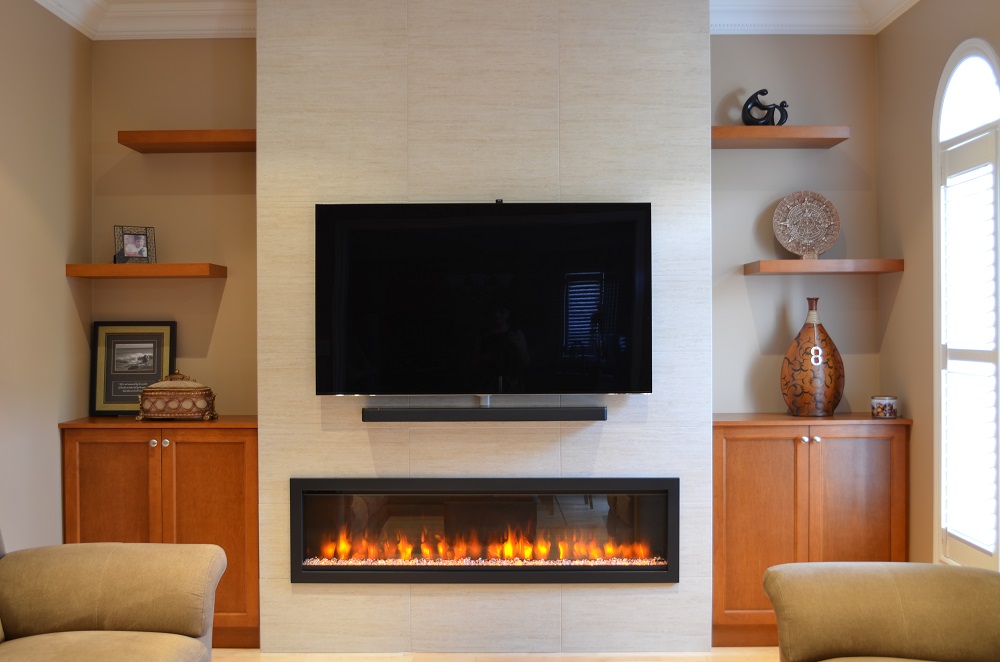As electric fireplace specialists, we answer questions about ‘How much heat do I need’ all the time. We know there are a lot of misconceptions when it comes to the topic of electric fireplaces vs. gas, especially when it comes to heat. To help you out, we’ve put together some guidelines.

How much heat do I need if the fireplace is supplemental to my furnace?
This is the most common scenario for most of our clients. Their furnace does a good job of heating their home, or most of the rooms. They may want a bit of heat from time to time, in a specific room. Maybe they have a room over the garage that’s always a bit colder than the rest of the house. In this scenario, you are looking for zone heating – heating just the area that you are using. You want enough heat to warm up the space, without affecting the thermostat on the furnace. In this scenario, you need flexible heat output that you can control. You also need to be sure that the minimum heat output of the fireplace doesn’t exceed the needs of the space.
With electric fireplaces, we equate a 1500 watt heater to approximately 5000 BTUs, and we are comfortable saying that this will heat up a 400 – 500 square foot space, when used as supplemental heating. With a gas fireplace, heat output is much higher, even in a small unit. If you look at a small gas fireplace with heat output of 20,000 BTUs, and you extrapolate that for the amount of space it will warm up, you come up with 1600 – 2000 square feet of coverage. If your room is smaller than that, then that gas fireplace will be too hot for the space. What happens when a gas fireplace is pumping out too much heat? You turn it off, because the flames are the source of heat. What happens when an electric fireplace pumps out too much heat? You turn off the heater but keep the flames running, because the flames are not the source of heat. In other words, for a single room, gas is usually too hot, and electric is more appropriate.

How much heat do I need if the fireplace is the main source of heat?
With electric heating, we have a simple calculation to provide a very rudimentary estimate of the amount of heat you need. In a room with an 8-foot ceiling, you can multiply the area of the room by 10, to determine the number of watts that you need in your electric heater. So, a 10-foot by 10-foot room, with an 8-foot ceiling height, needs (10×10)x10, or 1000 watts. With a 9-foot ceiling, you multiply the area by the ceiling height, multiplied by 1.25. So, the same 10-foot by 10-foot room with a 9-foot ceiling, needs [(10×10)x9] x 1.25, or 1125 watts. Electric fireplaces typically have 1500 watt heaters, so it seems like a no-brainer that an electric fireplace could be the sole source of heat in a small room. However, not all electric heaters are created equal, and many electric fireplace heaters are not designed for continual use. You need to find an electric fireplace with better-than-average heater durability and longevity, possibly one that was designated for commercial use. This is not your box-store electric fireplace!
As a main source of heat, a gas fireplace may be a better solution, as they certainly put out more heat than an electric fireplace. However, just like all things, you will need to find a quality fireplace that was designed for continual use during cold weather. This may not be the ‘builder’ unit at a bargain price.

How much heat do I need in a new home vs. an older home?
Homes being built today are much more energy-efficient than homes that were built 10, 20 or 30 years ago. This is a hard thing to wrap our heads around when we move from one of those homes to a new abode. Driven by climate awareness, building codes around the world are mandating that homes be better insulated, with better doors and windows, and lower energy consumption. This means that your new home won’t have cold rooms or drafty areas, even in basements. So, the fireplace that worked in your old house is likely to be inappropriate for a newer home. In fact, the number one complaint that we hear almost daily from visitors to our showroom, is that they can’t use the gas fireplaces in their homes because they get too hot. Homeowners are disappointed that no on in the building process told them what to expect. It’s no surprise to us that the best fireplace for new homes is an electric fireplace, because the flames may be operated without the heater, giving you complete control over how warm it will be. In new construction, it is highly unlikely that any space will be cool enough to allow for the heat output of a gas fireplace.
Stylish Fireplaces & Interiors specializes in electric fireplaces and custom designs. Their Toronto-area showroom features over 50 electric fireplaces, as well as all of the add-ons and finishing materials needed to finish a project. They are NFI-certified Hearth Design Specialists, and can consult on any fireplace project.
[ux_video url=”https://vimeo.com/416341105″]